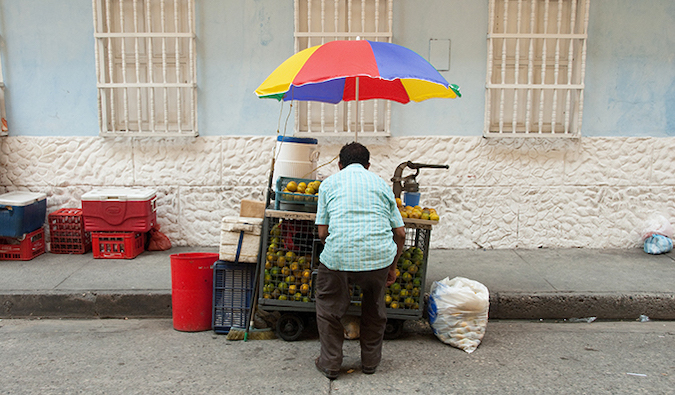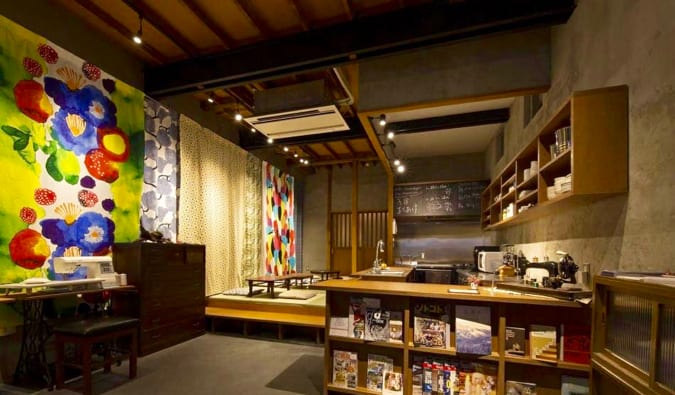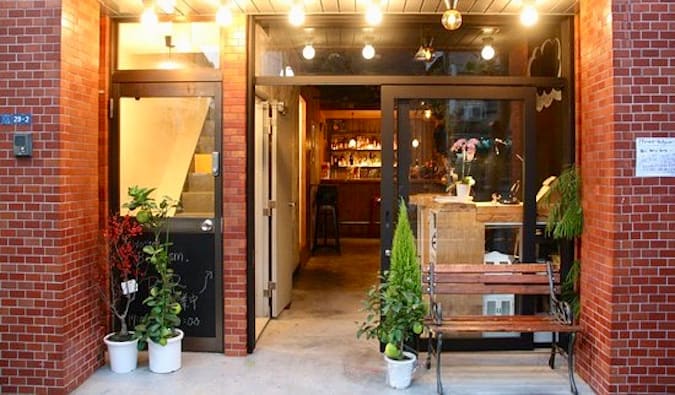
Posted: 6/6/19 | June 6th, 2019
A trip to Colombia wasn’t going to break the bank. I knew that much.
But would it be a bargain?
Only a visit there would tell me for sure.
And so, earlier this year, I spent over five weeks there, varying my time between dorm rooms and cooking my own food on the one hand and staying in boutique hotels and eating luxury meals on the other.
I can tell you that while people are right — Colombia isn’t going to break your bank — if you’re not careful, your costs can escalate quickly, especially if you indulge in the up-and-coming gastronomy scene.
So how much does it cost to visit Colombia?
And how can you save money there?
Let’s break it down and go over my trip as an example.
How much did I spend?

Over the course of 37 days, I spent $2,908.50 USD, or $78.60 per day. Here’s how that breaks down:
- Accommodation – 3,690,531 COP ($1122.10 USD)
- Food – 3,231,903 COP ($982.66 USD)
- Drinks (Starbucks, water, tea, etc.) – 183,488 COP ($55.78 USD)
- Alcoholic drinks – 691,170 COP ($210.15 USD)
- Taxis – 386,000 COP ($117.36 USD)
- Public transportation – 37,000 COP ($11.25 USD)
- Intercity buses – 238,200 COP ($72.42 USD)
- Uber – 518,447 COP ($157.63 USD)
- Walking/day tours- 541,500 COP ($164.64 USD)
- Miscellany (Band-Aids, soap, etc.) – 47,650 COP ($14.48 USD)
Total: 9,565,889 COP ($2908.50)
I spent so much money for two reasons: I stayed in a lot of hotels, and I ate out at a lot of fancy restaurants. They destroyed my budget. If it wasn’t for those things, I figure I would have spent about $1,000 less (thanks, Cartagena, for those lovely but pricey boutique hotels!) or around $53 per day, which isn’t too bad, and closer to my ideal $50 a day budget.
I don’t have any regrets, though. I had a lot of friends visit me and it was hard to convince them to stay in hostels and eat cheap meals. They wanted to splurge in the few days they had.
How much do you need to travel in Colombia?

Accommodation – Most hostel dorm rooms in Colombia cost between 30,000-45,000 COP ($9-14 USD) per night, though in smaller cities and towns you can find them as low 23,048 COP ($7 USD) per night. You can sometimes find them that low in the big cities but the facilities tend to be pretty meh. Private hostel rooms start around 50,000 COP ($15.50 USD), though during the high season and in major metropolitan areas, you’ll likely spend double that.
Budget hotels in Colombia start around 60,000 COP ($18 USD) per night. On the coast and in the high season, you’ll find most places will be closer to around 120,000 ($36 USD) per night. If you’re looking to stay at some of the really nice boutique hotels the country has to offer, you should expect to pay around 658,533 COP ($200 USD) or more a night.
Airbnb is available in the larger cities, with shared accommodation prices starting around 35,000 COP ($11 USD) per night. For an entire home or apartment, prices start at 90,000 COP ($28 USD) but average closer to 250,000 COP ($78 USD) per night.
Food – Most of the local food is around 10,000-15,000 COP ($3-5 USD) per meal. You can find a lot for around 5,000-10,000 ($1.50-3 USD) in the countryside. You can also find a lot of cheap food like empanadas for like 200-500 COP ($0.06-0.15 USD) (they make the best snack food). An arepa on the street will be about 3,000 COP ($0.90 USD). Ceviche, which is popular throughout the country, is around 15,000 COP ($4.55 USD).
Most “Western” food will cost about 20,000-30,000 COP ($6-9 USD) each, or 15,000 COP ($4.55 USD) if you get fast food like McDonald’s or Subway. You can find some really expensive food in the country so prices just go up from that. Beer at the bar can be found for as little as 2,500 COP ($0.75 USD) but, on average, you’re likely to pay double that a backpacker bar. Cocktails, which are becoming really popular here, cost around 20,000 COP ($6 USD).
Grocery shopping is very cheap, costing about 110,000 COP ($34 USD) per week if you plan on buying your own groceries.
Transportation – Local transportation is cheap. The metro in Medellin is only around 2,500 COP ($0.76 USD) for a one-way fare. Local buses are the most common type of transportation in towns and cities. The fare is usually between 1,000-2,5000 COP ($0.30-0.80 USD).
Uber (a ridesharing service) is way cheaper than taxis and you can pretty much get anywhere for around 16,463 COP ($5 USD). You can save $15 off your first Uber ride with this code: jlx6v.
Intercity buses are the best way to get around Colombia. A bus from Bogota to Medellin will cost around 65,000 COP ($20 USD) while a bus to Quito, Ecuador from Bogota will cost around 175,000 COP ($54 USD). Medellin to Manizales is 42,000 COP ($12.75 USD) and Salento to Cali is about 27,000 COP ($8.20 USD). On average, you’ll probably spend 20,000-40,000 ($6-12 USD) for a bus, more if you’re going over 9 hours.
Companies like Bolivariano, Expreso Palmira, and Trejos are all good companies and they make it easy to research schedules and fares on their websites.
Tours – Most tours cost around 30,000 COP ($9 USD) and most museums are 10,000 COP ($3 USD) or less.
I don’t think you need to spend a lot of money in Colombia. On a backpacker’s budget, you’ll probably spend about 160,000 COP ($48 USD) per day. This is assuming you’re staying in a hostel, eating local food, cooking some of your own meals, and using local transportation to get around. You’ll roughly spend around 60,000 COP ($18 USD) per day on hostels, 30,000-40,000 ($9-12 USD) on food, and 60,000 COP ($18 USD) on everything else. If you plan to drink a lot, do more tours, or eat a lot more Western food, I’d probably budget between 181,097-197,560 COP ($55-60 USD) per day.
On a mid-range budget of about 306,000 COP ($92 USD) per day, you can afford a private room at a hostel, Airbnb, or hotel; eat anywhere you want within reason (splurging once in a while); fly a couple of times, and take whatever tours you want. You’re going to spend around 99,000-132,000 COP ($30-40 USD) per night on lodging, 99,000 ($30 USD) on food, and 99,000 ($30 USD) on everything else.
If you’re going to stick to more luxury hotels, meals, drink more, or not use any points, I’d budget maybe 329,266 COP ($100 USD) or so a day.
After that, the sky is really the limit.
I found my trip a good in between. In the next section, I’ll talk more about how to save money in Colombia but, overall, I didn’t really want for anything on my trip. I ate cheap when I wanted, balanced my partying, cooked some food, used hotel points when I could, took public transportation as much as I could, and, just overall, tried to balance the two budget types above.
How to save money in Colombia

You don’t need to do a lot to save money in Colombia. It’s relatively cheap to visit, and there are a lot of good deals throughout the country.
Accommodation is inexpensive unless you are staying at major hotels chains. Hostels are cheap (especially when you leave the big cities) and there are a lot of great value local hotels throughout the country. There are a ton of markets with cheap food. Local attractions are cheap. Buses are cheap. Really, if you travel as your average Colombian lives, you’ll be hard pressed to spend a lot.
Here are my 12 tips on how to save money in Colombia:
Eat like locals – It’s easy to eat on a budget here if you stick to local Colombian food. You can also find a lot of cheap food like empanadas for like 200-500 COP ($0.06-0.15 USD) (they make the best snack food). An arepa on the street will be about 3,000 COP ($0.90 USD). Ceviche, which is popular throughout the country, is around 15,000 COP ($4.55 USD). In the countryside, you can find meals closer to 10,000 COP ($3 USD)! In short: eat local, eat cheap. Sure, Colombian food isn’t the healthiest (it’s heavy on meat and fried food) but it is filling and inexpensive.
Skip the cocktails – Colombia has a lot of awesome cocktail bars now — especially in Medellín — but these drinks are expensive, usually costing around 20,000 COP ($6 USD) (sometimes up to 30,000 COP, or $9 USD). I mean, that’s crazy, especially when beer will cost you around 4,000 COP ($1.25 USD). If you’re on a budget, you should definitely skip the cocktails and stick to beer.
Cook your food – While local food is really cheap, you can also save some money by grocery shopping, although I didn’t find it to be a great value. It cost me 50,568 COP ($15 USD) for three days of food (plus, the hostels had terrible cooking facilities). If you do shop, I recommend getting breakfast food or snacks and eating meals out. You get more bang for your buck that way.
Avoid the hostels on the Caribbean coast – The hostels on the Caribbean coast were pretty lackluster. They were expensive and didn’t have great facilities, especially the bigger “resort” ones in beachside towns like Palomino. Instead, you can find comparatively cheap budget hotels on Booking.com for less than a private room and only slightly more than a dorm bed.
Avoid Gringolands – Everything where the gringos are is double the normal price. Avoid staying in areas with lots of tourists and expats, like Poblado in Medellín, Cartagena’s Old Town, or Park 93 in Bogotá, since you’ll end up paying more for everything.
Couchsurf – Nothing’s cheaper than free. Couchsurfing connects you with locals who will not only give you a free place to stay but also serve as a local tour guide and introduce you to the cool stuff only locals know about in town! You’ll find the most hosts in college towns and big cities.
Fly Viva Air – If you’re planning to fly around Colombia, the best deals are on Viva Air. It has the cheapest fares in the country (though it flies to the fewest places). It’s best to book a few weeks in advance. (LAN and Avianca, the two major carriers, also have deals sometimes.)
Use miles and points – You can use your miles on both LAN (part of Oneworld) and Avianca (part of Star Alliance). There are also a lot of hotel chains for which you can use points. If you have miles and/or points, you can burn through a lot of them in Colombia — and the redemption rates are really good too!
Avoid the airline surcharge – Non-Colombians are charged higher ticket prices than locals. If you look at the non-local version of the website, you won’t see the super saver cheap fares. To get around this, load up the local Spanish versions of an airlines’ websites. Then use your browser extension to translate the pages and book away! You’ll see the cheaper, Colombian prices, and no one will challenge you at check-in about your ticket fare.
Take Uber – Uber is by far the cheapest way to get around Bogotá, Cali, and Medellín. It’s about 1/3 as much as taxis. (Note: Uber is actually illegal, so don’t sit in the back seat or you might get stopped.) I also like to tip the Uber drivers here, since the fares are so cheap and they are taking a risk. But all the drivers I met did this out of necessity — they couldn’t pay their bills if it wasn’t for Uber.
Haggle with taxi drivers – There are no meters in Colombia. While prices from the airports are regulated and non-negotiable, everything else is just a matter of your bargaining skills. If you’re going to take taxis, haggle before you get in the car.
Take free walking tours – Most major and medium-sized cities in Colombia have free walking tours. They are a good way to see the city on a budget and learn by asking your guide questions. Here are some of my favorites:
- Free Walking Tour Cartagena
- Free Walking Tour Bogota
- Real City Tours Medellin
Colombia is a pretty affordable country if you watch your spending on food and accommodation. On most days, when I wasn’t eating fancy dinners, I found myself spending less than 134,850 COP ($40 USD), especially if I was staying in dorms. Prices are also a lot cheaper in the southern and eastern parts of the country — I was paying 25,000 COP ($7.50 USD) a night for my own room in Popayan and about a quarter for empanadas!
In short, Colombia is easy to visit on a budget. Since you already know how much I love the place, you won’t be surprised that I recommend you book a trip (and try some of the delicious cuisine)!
Book Your Trip to Colombia: Logistical Tips and Tricks
Book Your Flight
Find a cheap flight by using Skyscanner or Momondo. They are my two favorite search engines because they search websites and airlines around the globe so you always know no stone is left unturned.
Book Your Accommodation
You can book your hostel with Hostelworld. If you want to stay somewhere other than a hostel, use Booking.com as they consistently return the cheapest rates for guesthouses and cheap hotels. I use them all the time.
Don’t Forget Travel Insurance
Travel insurance will protect you against illness, injury, theft, and cancellations. It’s comprehensive protection in case anything goes wrong. I never go on a trip without it as I’ve had to use it many times in the past. I’ve been using World Nomads for ten years. My favorite companies that offer the best service and value are:
- World Nomads (for everyone below 70)
- Insure My Trip (for those over 70)
Looking for the best companies to save money with?
Check out my resource page for the best companies to use when you travel! I list all the ones I use to save money when I travel – and I think will help you too!
Looking for more information on visiting Colombia?
Check out my in-depth destination guide to Colombia with more tips on what to see, do, costs, ways to save, and much, much more!
The post How Much Does it Cost to Travel Colombia? appeared first on Nomadic Matt's Travel Site.


















